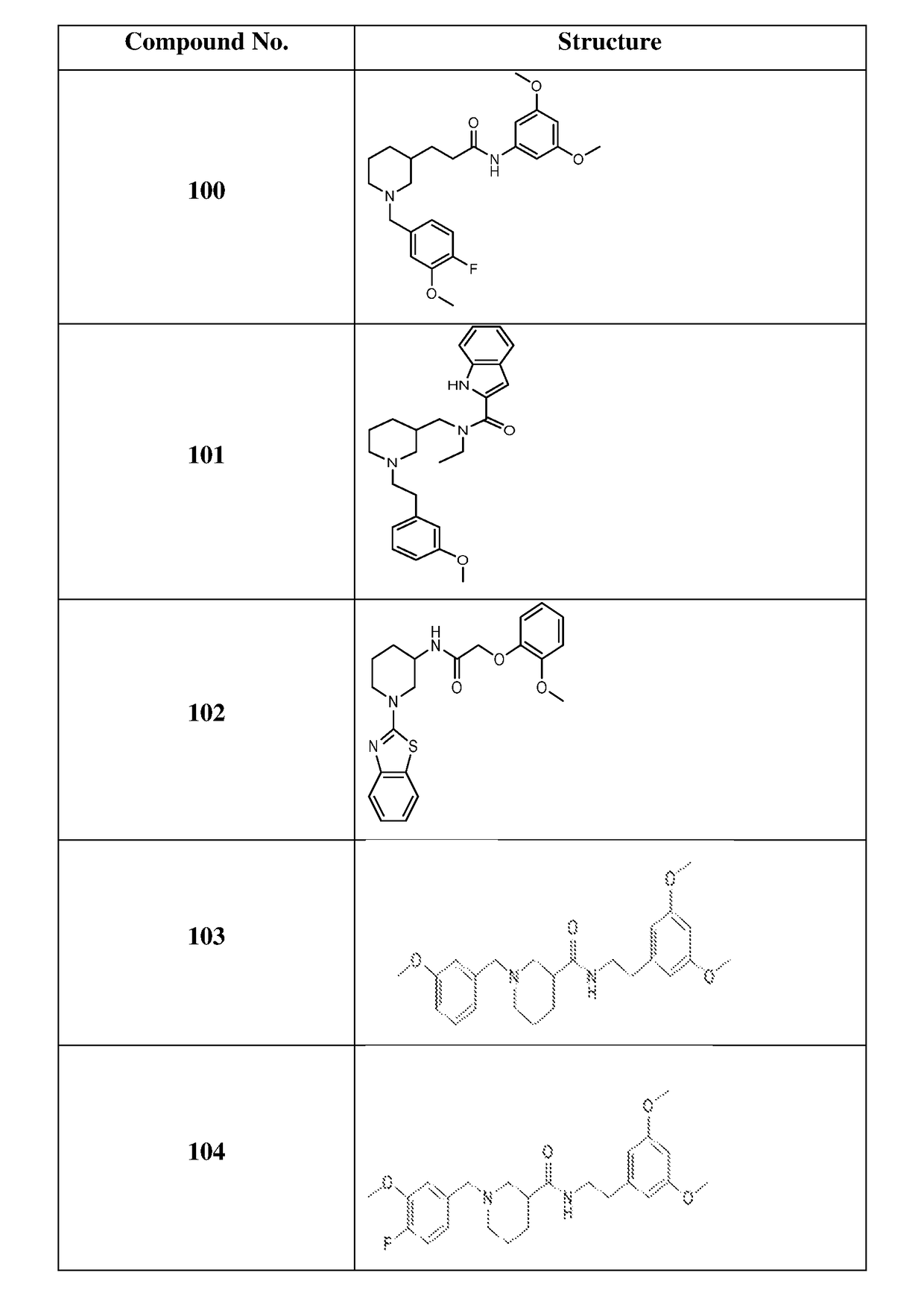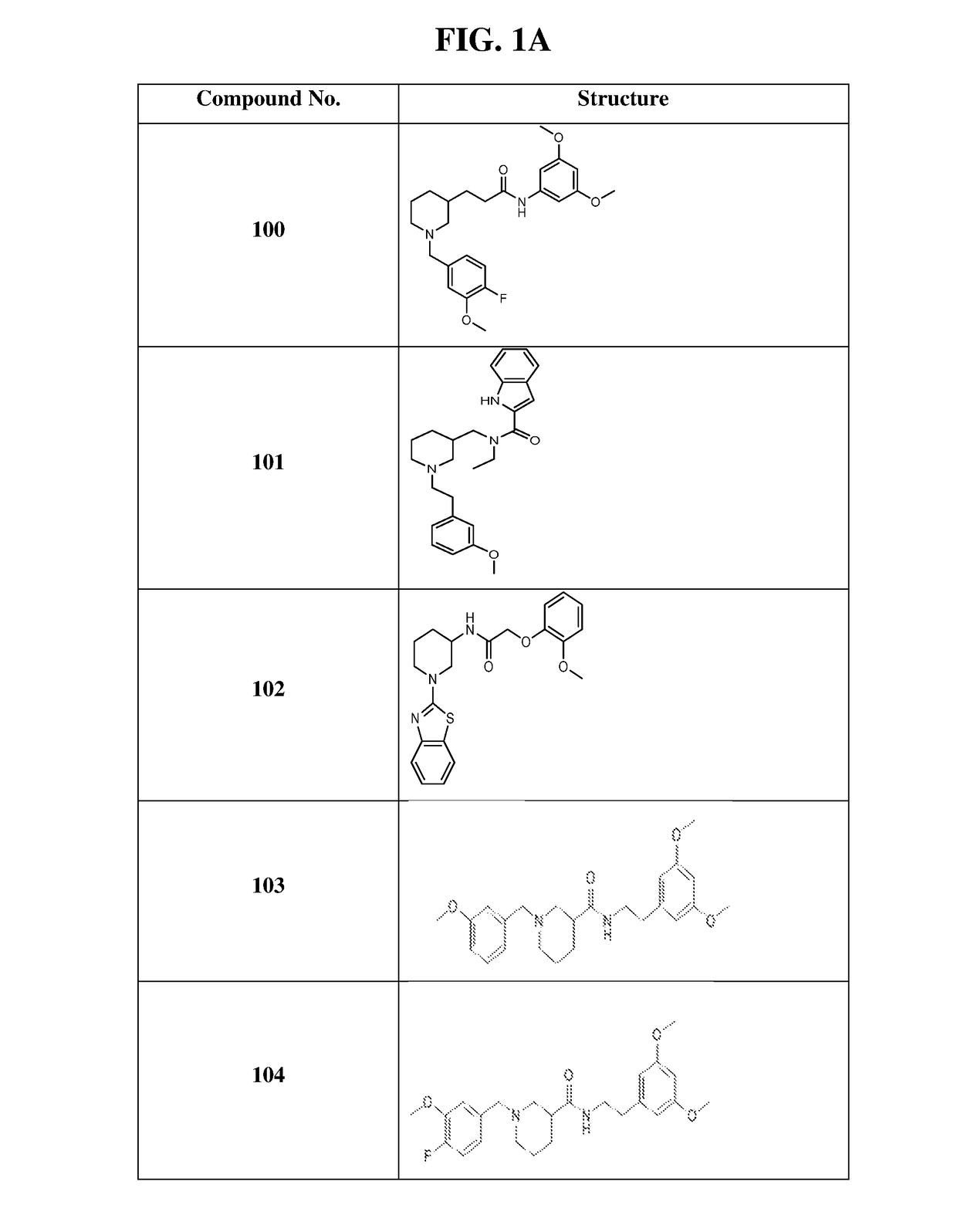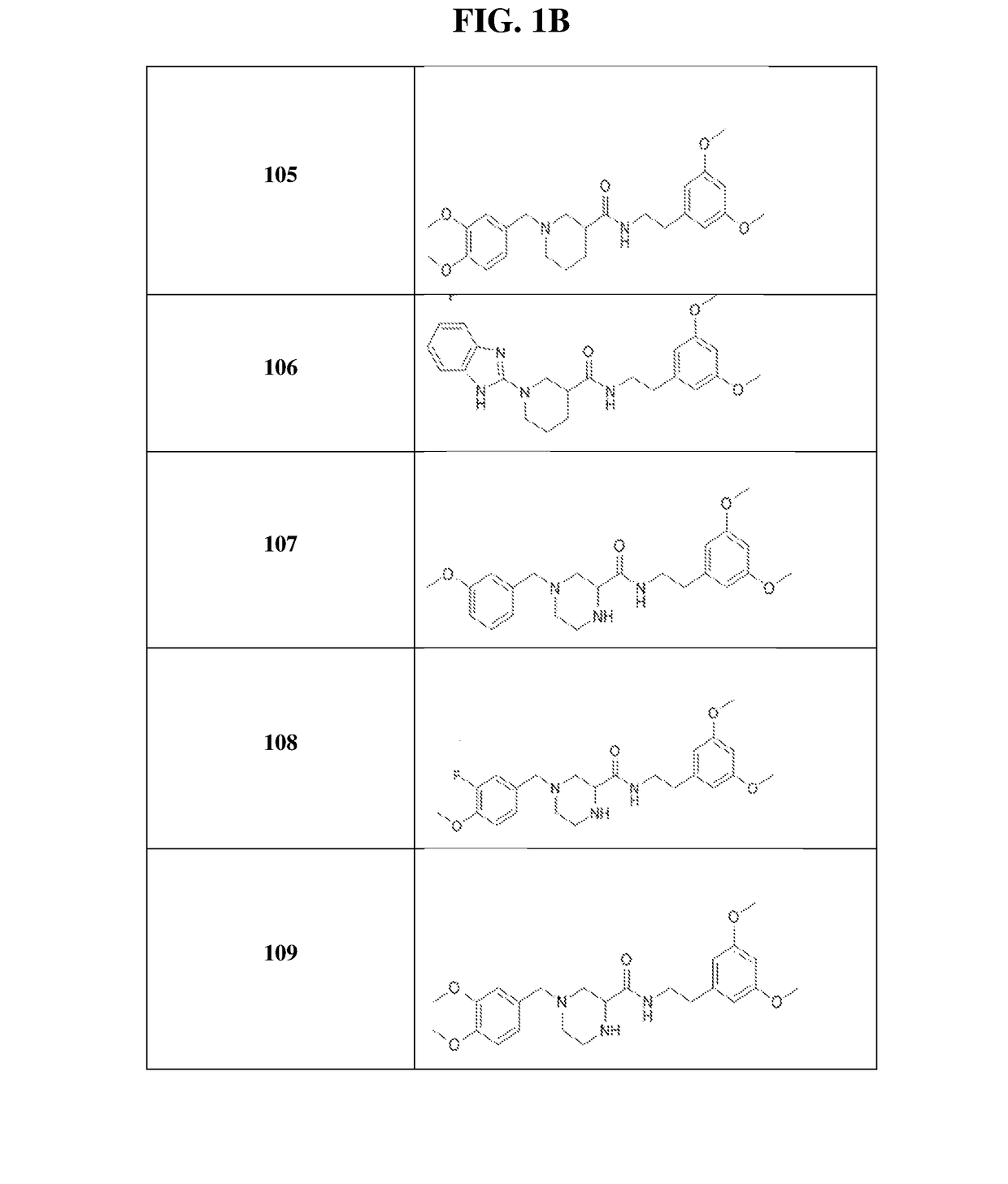Compounds, compositions and methods of use against stress granules
a technology of stress granules and compounds, applied in the field of compound compositions and methods of use against stress granules, can solve problems such as difficulty in disaggregating, impaired function, and inability to disaggrega
- Summary
- Abstract
- Description
- Claims
- Application Information
AI Technical Summary
Benefits of technology
Problems solved by technology
Method used
Image
Examples
example 1
of N-(3,5-dimethoxyphenyl)-3-(1-(4-fluoro-3-methoxybenzyl)-piperidin-3-yl)propanamide (Compound 100)
[0321]
Step 1: Synthesis of A2
[0322]
[0323]To a solution of A1 (2 g, 13 mmol, 1.00 eq) in dioxane (50 mL) was added cone. HCl (2 mL). The mixture was stirred at 25° C. for 30 min and the solvent was evaporated under reduced pressure. The residue was dissolved into AcOH (50 mL) and PtO2 (487 mg, 2.2 mmol, 0.15 eq) was added. The suspension was degassed under vacuum and purged with H2 several times. The mixture was stirred under H2 (50 psi) at 25° C. for 12 hrs, at which point LCMS showed the reaction was complete. The mixture was diluted with water (100 mL) and filtered, and the catalyst washed with water, keeping the catalyst wet at all times. The filtrate was concentrated under reduced pressure to afford A2 (2 g, 13 mmol, 95.0% yield) as a white solid. 1H NMR: (CDCl3 400 MHz) δ 3.29 (d, J=11.8 Hz, 2H) 2.83 (t, J=12.2 Hz, 1H) 2.60 (t, J=11.8 Hz, 1H) 2.38 (br. s., 2H) 1.86 (d, J=11.8 Hz,...
example 2
of N-ethyl-N-((1-(3-methoxyphenethyl)piperidin-3-yl)methyl)-1H-indole-2-carboxamide (Compound 101)
[0328]
Step 1: Synthesis of A2
[0329]
[0330]To a solution of ethanamine;hydrochloride (853 mg, 10.5 mmol) in 3:1 of DCM (15 mL):THF (5 mL) was added A1 (2.00 g, 8.72 mmol), TEA (6.18 g, 61.0 mmol), EDCI (3.34 g, 17.4 mmol) and HOBt (2.36 g, 17.4 mmol) at 20° C. The reaction solution was stirred at 20° C. for 12 hrs, after which TLC (Petroleum ether: Ethyl acetate=0:1, Rf=0.4) showed that the starting material was consumed. The reaction mixture was poured into water (200 mL) and extracted with DCM / MeOH (v / v=95 / 5, 70 mL*3). The organic layers were combined and concentrated in vacuo to give a residue. The crude product was purified by column chromatography on silica gel (Petroleum ether: Ethyl acetate=10:1 to 2:1) to give A2 (2.10 g, yield: 93.95%) as a red oil. The product was used directly to the next step. 1H NMR: (MeOD 400 MHz) δ: ppm 4.07-3.97 (2H, m), 3.21-3.16 (2H, m), 2.80 (2H, m), 2....
example 3
of N-(1-(benzo[d]thiazol-2-yl)piperidin-3-yl)-2-(2-methoxyphenoxy)acetamide (Compound 102)
[0339]
Step 1: Synthesis of A3
[0340]
[0341]To a mixture of A2 (501 mg, 2.75 mmol), HOBT (507 mg, 3.75 mmol) and EDCI (719 mg, 3.75 mmol) in DMF (5.00 mL) were added DIEA (1.29 g, 10.0 mmol) and A1 (500 mg, 2.50 mmol) at 20° C. The mixture was stirred at 20° C. for 12 h until LCMS showed that the reaction was completed. The mixture was dissolved in EtOAc (30 mL) and washed with water (30 mL*2) and brine (20 mL*2). The organic phase was dried over Na2SO4, filtered and the filtrate was concentrated under vacuum to provide a residue, which was purified by silica gel chromatography (petroleum ether / ethyl acetate=30 / 1 to 1 / 1) to give A3 (800 mg, yield: 88%) as yellow oil. 1H NMR: (CDCl3 400 MHz) δ: 7.08-7.16 (m, 1H), 7.00-7.06 (m, 1H), 6.91-6.95 (m, 3H), 5.30-5.32 (m, 1H), 4.52-4.55 (m, 2H), 3.97-4.06 (m, 1H), 3.88-3.91 (m, 3H), 3.66-3.76 (m, 1H), 3.46-3.55 (m, 1H), 3.22-3.33 (m, 1H), 1.86-1.95 (m, 1H)...
PUM
| Property | Measurement | Unit |
|---|---|---|
| temperature | aaaaa | aaaaa |
| temperature | aaaaa | aaaaa |
| temperature | aaaaa | aaaaa |
Abstract
Description
Claims
Application Information
 Login to View More
Login to View More - R&D
- Intellectual Property
- Life Sciences
- Materials
- Tech Scout
- Unparalleled Data Quality
- Higher Quality Content
- 60% Fewer Hallucinations
Browse by: Latest US Patents, China's latest patents, Technical Efficacy Thesaurus, Application Domain, Technology Topic, Popular Technical Reports.
© 2025 PatSnap. All rights reserved.Legal|Privacy policy|Modern Slavery Act Transparency Statement|Sitemap|About US| Contact US: help@patsnap.com



